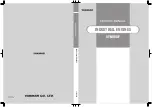
Vehicle Systems
Testing and Adjusting
50
Lift Cylinders Air Removal
After the lift cylinder has been disassembled and
then assembled again, it may be necessary to
remove the air (bleed) from the cylinder.
1.
With no load, lift and lower the mast and carriage
through one complete cycle.
2.
With the forks on the floor, check the oil level in
the hydraulic tank. Add oil (if necessary) to bring
the oil level to the full mark.
3.
With no load, left and lower the mast and
carriage again through four complete cycles.
WARNING
The oil will have high pressure present. To
prevent personal injury, do not remove the bleed
screws completely . Keep hands and feet away
from any parts of the truck that move, because
the forks will lower when the bleed screw is
loose.
4.
Lift the forks high enough to put a load on all
stages of the lift cylinders. (The illustrations
shown are of a full free triple lift mast.).
Lift Cylinder Air Removal (FFTL - Primary Cylinder)
(23) Bleed Screw.
Lift Cylinder Air Removal (FFTL - Secondary Cylinders)
(24) Bleed Screw.
5.
Open bleed screws (23 and 24) no more than
one turn. The weight of the carriage will force air
and hydraulic oil out of the cylinders through the
bleed screws. Close the bleed screws before all
the pressure is out of the cylinders. This will
prevent air from entering back through the bleed
screws.
6.
Repeat Steps 4 and 5 until there is no air bubbles
at the bleed screws.
7.
After all the air is removed, tighten the bleed
screws.
8.
Fill the hydraulic tank to the full mark.
9.
Lift and lower the mast and carriage again
hrough one complete cycle. If the mast does not
operate smoothly, repeat Step 3 through 9.













































